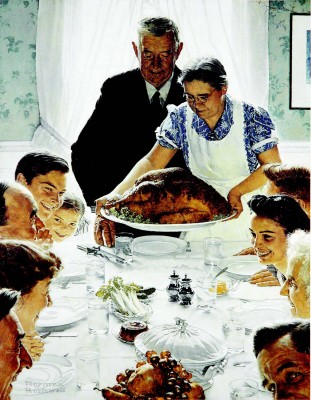 Where did your family eat dinner last night? In front of the TV? In the car on the way to sport? At McDonalds? At the dinner table? A survey taken a few years ago in the US, Canada and Britain, found that about a quarter of adults with children under the age of 18 ate dinner together at home seven nights a week. Another quarter said they ate together three or fewer nights a week. I am going to surmise that Australian households would not be too far off those figures.
Where did your family eat dinner last night? In front of the TV? In the car on the way to sport? At McDonalds? At the dinner table? A survey taken a few years ago in the US, Canada and Britain, found that about a quarter of adults with children under the age of 18 ate dinner together at home seven nights a week. Another quarter said they ate together three or fewer nights a week. I am going to surmise that Australian households would not be too far off those figures.
Once upon a time (not that long ago) we know that the situation was different. Each night the dining table would be set with a simple cloth and serviettes, the cutlery and crockery would be laid out and as ‘dinner time’ neared an increasing number of hungry mouths would appear with the question, “what’s for dinner”?
What accounts for this decline in families eating together today though? The data seems to point to two main issues: Overworked parents and overscheduled children. When mum and dad get home in the evening they are soon in the car again to whisk the children off to sport, music, tutoring, church activities and a host of other events.
This nightly ritual around the dinner table however is both vital and fruitful: it is what anchors a family together. Sure, the conversation is not always profound and children argue and fidget. And sometimes the deepest and most meaningful times in a family are not at the table at all. However, even with all that in mind there is something unique about the time a family spends around the dinner table eating a meal together.
The security of the dinner table is a central place for the family to return to whether the times are joy filled, sorrowful or somewhere in between. It is the place where the family builds an identity. Stories are passed down, jokes exchanged and the wider world is examined through the lens of the family’s values. Children pick up vocabulary and a sense of how conversation is structured. They learn good manners and proper etiquette, something that will set them up for life. Meal time is often the time that families pray together. Dinner time is not ‘parent time’ or ‘children time’ but it is truly ‘family time’. Coming back daily to the same place helps instill familiarly. When a family closes their front door to world each night and sits down together around the table, they are subliminally stating, ‘this is what is most important to us; this is where we truly exist.’
Striving for regular family meals is not mere idealism. Experts in adolescent development are the ones who are saying that the daily investment in family time pays the largest dividends. Studies show that the more families eat together, the less likely the children are to smoke, drink, take drugs, get depressed, develop eating disorders and consider suicide, and the more likely they are to do well in school, delay having sex, eat their vegetables and learn how to socialise. One anthropologist at Rutgers University in New Jersey stated, “If it were just about food, we would squirt it into their mouth with a tube. A meal is about civilizing children. It’s about teaching them to be a member of their culture”. You might recall the riots in England in 2011, to what extent would that have happened if families were at home having dinner? Especially in an era when divorce and family breakdown are at such high levels, the need becomes all the more urgent for children and parents to set down together and get to know each other once again.
There is no one-size-fits-all for families in regards meal times but it might be of benefit to really take a hard look at your family routine. Is it overbooked? Are you tired and frantic? Will your children be better off with more activities in their week? Why not cut back on a few activities and spend some unstructured time with your family? Start by planning some stay at home family dinners together. Set the table, turn off the TV and enjoy a meal together. Just a thought.
Copyright 2014 Bernard Toutounji
About the Author

Guest
We welcome guest contributors who graciously volunteer their writing for our readers. Please support our guest writers by visiting their sites, purchasing their work, and leaving comments to thank them for sharing their gifts here on CatholicMom.com. To inquire about serving as a guest contributor, contact editor@CatholicMom.com.


.png?width=1806&height=731&name=CatholicMom_hcfm_logo1_pos_871c_2728c%20(002).png)
Comments